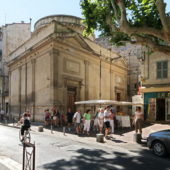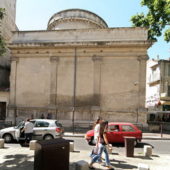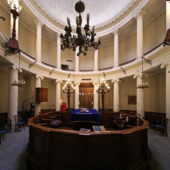Jewish history in Avignon and Provence can be traced back at least to the 2nd Century CE.
The rabbi of the Avignon Synagogue is Jonathan Sfadj. Rabbi Sfadj invites you to contact him if you wish to visit the synagogue.
Email: rabinacia@hotmail.fr Telephone: 06 85 67 13
This neo-classically styled synagogue dates from 1846, replacing an earlier building destroyed by fire. With its domed rotunda and interior 2-storey colonnade, this design, by architect J.A. Jeoffroy, represents a deliberate break with earlier traditions that emphasized liberal use of color, a more extravagant or baroque, feeling.
Jewish history in Avignon and Provence can be traced back at least to the 2nd Century CE, but it is in the 13th Century when the Jewish presence in Avignon becomes more prominent with the establishment of a Jewish Ghetto in the city. In 1221, the synagogue was opened and the town’s Jews have gathered on this site ever since.
According to the historical sources, including the Jewish Encyclopedia, the Jews of Avignon enjoyed relative protection and respect within the Avignon community, benefiting from the protection of a succession of popes. They were employed in occupations ranging from farmers and laborers to doctors, merchants and moneylenders. However, with the onset of the Inquisition in the 16th and 17th centuries along with periodic outbreaks of pestilence and regional warfare, the Jews sometimes found themselves as the scapegoats for the problems of the larger community, enduring periods of religious oppression, violence and heavy taxes.
This early synagogue was rebuilt by 1767 by an architect named Franque, who utilized the ornate style typical of that era to design and decorate the building. With the French Revolution, the Jews of France suddenly found themselves largely liberated from life in the ghetto. Over the next several decades, many homes in the Jewish section of town were town down and replaced.
The Sephardic congregation celebrated a liturgy, the Comtadin, common to Jews of the greater Provence region that had a distinct Portuguese influence. However, the liturgy notably deviated from this style with omission of the Alenu prayer and the substitution of the Shalom rab for Sim Shalom among other differences.
The current synagogue, used occasionally by the 40 or so Jewish families who still reside in Avignon, is a statement of neo-classical proportion and plainness on its exterior while its interior, with nary a splash of color, features staid walnut fixtures and stark white Ionic columns on the ground floor with Corinthian columns on the second story.
Visits are welcome at the synagogue from 10am-noon and 3-5pm (closed Friday afternoon and on weekends).






